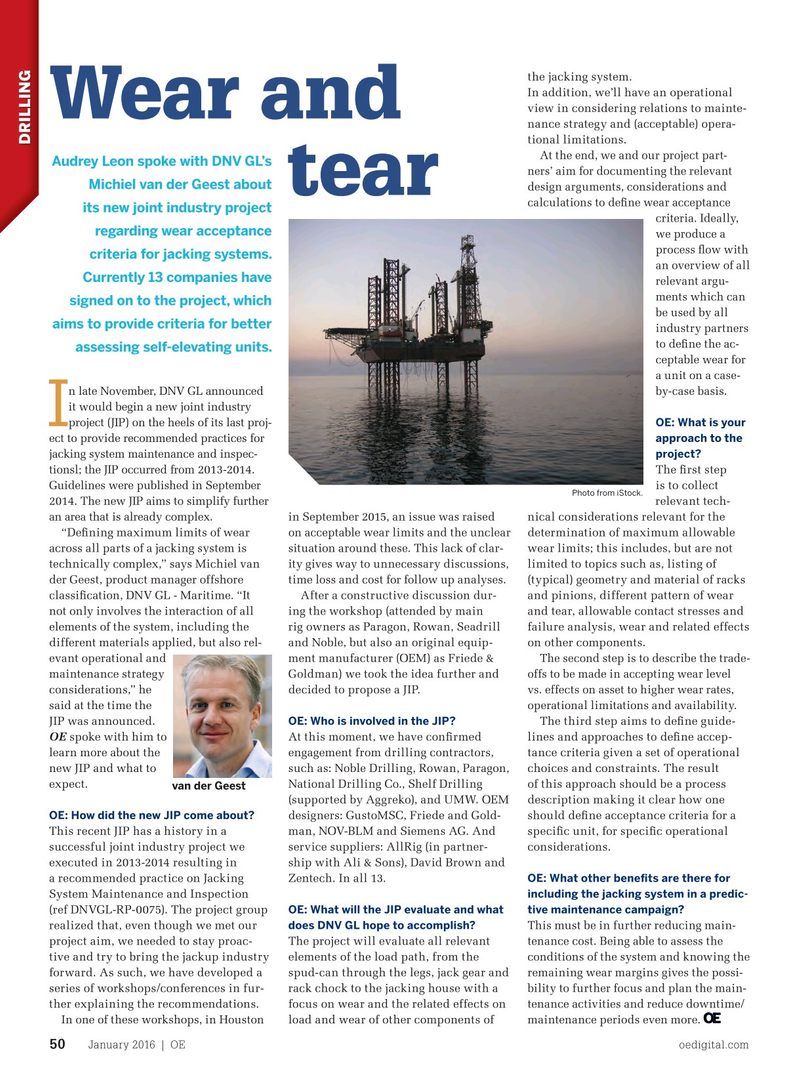
Page 48: of Offshore Engineer Magazine (Jan/Feb 2016)
Read this page in Pdf, Flash or Html5 edition of Jan/Feb 2016 Offshore Engineer Magazine
the jacking system.
In addition, we’ll have an operational view in considering relations to mainte-
Wear and nance strategy and (acceptable) opera- tional limitations.
DRILLING
At the end, we and our project part-
Audrey Leon spoke with DNV GL’s ners’ aim for documenting the relevant
Michiel van der Geest about design arguments, considerations and tear calculations to de? ne wear acceptance its new joint industry project criteria. Ideally, regarding wear acceptance we produce a process ? ow with criteria for jacking systems. an overview of all
Currently 13 companies have relevant argu- ments which can signed on to the project, which be used by all aims to provide criteria for better industry partners to de? ne the ac- assessing self-elevating units.
ceptable wear for a unit on a case- n late November, DNV GL announced by-case basis.
it would begin a new joint industry
I OE: What is your project (JIP) on the heels of its last proj- approach to the ect to provide recommended practices for project?
jacking system maintenance and inspec-
The ? rst step tionsl; the JIP occurred from 2013-2014. is to collect
Guidelines were published in September
Photo from iStock.
relevant tech- 2014. The new JIP aims to simplify further nical considerations relevant for the an area that is already complex. in September 2015, an issue was raised “De? ning maximum limits of wear determination of maximum allowable on acceptable wear limits and the unclear across all parts of a jacking system is wear limits; this includes, but are not situation around these. This lack of clar- technically complex,” says Michiel van limited to topics such as, listing of ity gives way to unnecessary discussions, der Geest, product manager offshore (typical) geometry and material of racks time loss and cost for follow up analyses. classi? cation, DNV GL - Maritime. “It and pinions, different pattern of wear
After a constructive discussion dur- not only involves the interaction of all and tear, allowable contact stresses and ing the workshop (attended by main elements of the system, including the failure analysis, wear and related effects rig owners as Paragon, Rowan, Seadrill different materials applied, but also rel- on other components. and Noble, but also an original equip-
The second step is to describe the trade- evant operational and ment manufacturer (OEM) as Friede & offs to be made in accepting wear level maintenance strategy
Goldman) we took the idea further and vs. effects on asset to higher wear rates, considerations,” he decided to propose a JIP. operational limitations and availability.
said at the time the
OE: Who is involved in the JIP?
JIP was announced. The third step aims to de? ne guide-
At this moment, we have con? rmed
OE spoke with him to lines and approaches to de? ne accep- engagement from drilling contractors, learn more about the tance criteria given a set of operational such as: Noble Drilling, Rowan, Paragon, new JIP and what to choices and constraints. The result
National Drilling Co., Shelf Drilling expect. of this approach should be a process van der Geest (supported by Aggreko), and UMW. OEM description making it clear how one
OE: How did the new JIP come about? designers: GustoMSC, Friede and Gold- should de? ne acceptance criteria for a
This recent JIP has a history in a speci? c unit, for speci? c operational man, NOV-BLM and Siemens AG. And successful joint industry project we considerations.
service suppliers: AllRig (in partner- executed in 2013-2014 resulting in ship with Ali & Sons), David Brown and
OE: What other bene? ts are there for a recommended practice on Jacking
Zentech. In all 13.
including the jacking system in a predic-
System Maintenance and Inspection
OE: What will the JIP evaluate and what tive maintenance campaign?
(ref DNVGL-RP-0075). The project group does DNV GL hope to accomplish?
This must be in further reducing main- realized that, even though we met our tenance cost. Being able to assess the project aim, we needed to stay proac- The project will evaluate all relevant conditions of the system and knowing the tive and try to bring the jackup industry elements of the load path, from the remaining wear margins gives the possi- forward. As such, we have developed a spud-can through the legs, jack gear and bility to further focus and plan the main- series of workshops/conferences in fur- rack chock to the jacking house with a tenance activities and reduce downtime/ ther explaining the recommendations. focus on wear and the related effects on
In one of these workshops, in Houston maintenance periods even more. load and wear of other components of
January 2016 | OE oedigital.com 50 000_OE0116_Drilling_DNVGL.indd 50 12/24/15 9:13 AM

 47
47

 49
49